Menus
- object of desire
- Yoshimura five-speed racing transmission replaces the standard gearbox
- 1979 already 47,000 marks expensive
- You only have to get used to the sitting position
- The Egli MRD1 is still a drug
- A lot of air also needs a lot of gasoline
- Technical data Egli MRD1 (1979)

Gargolov

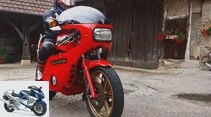
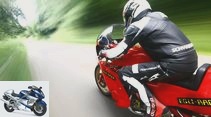
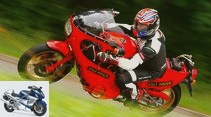
28 photos
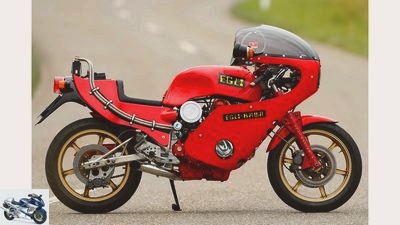
Gargolov.
1/28
Egli MRD1.
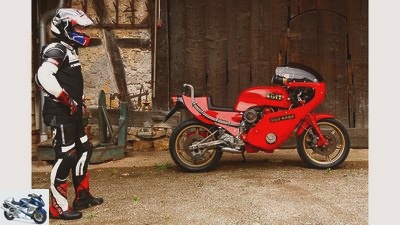
Gargolov.
2/28
Egli MRD1.
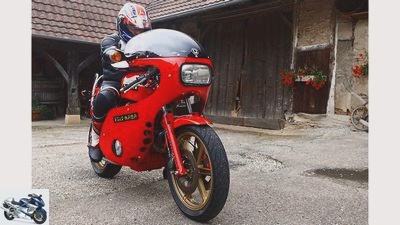
Gargolov.
3/28
Egli MRD1.
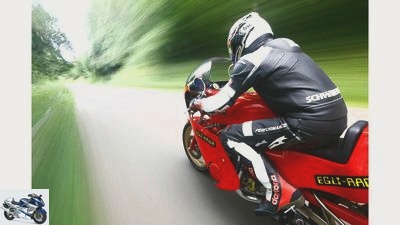
Gargolov.
4/28
Egli MRD1.
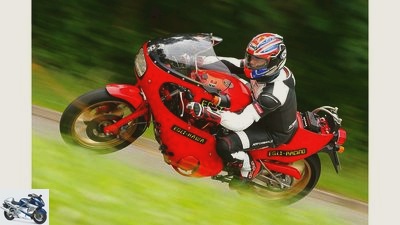
Gargolov.
5/28
Egli MRD1.
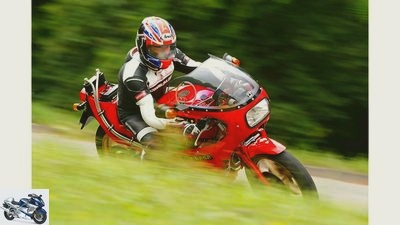
Gargolov.
6/28
Egli MRD1.
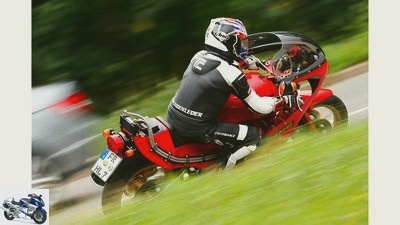
Gargolov.
7/28
Egli MRD1.
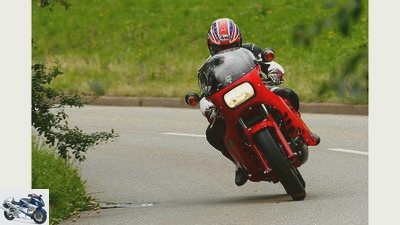
Gargolov.
8/28
Egli MRD1.

Gargolov.
9/28
Egli MRD1.
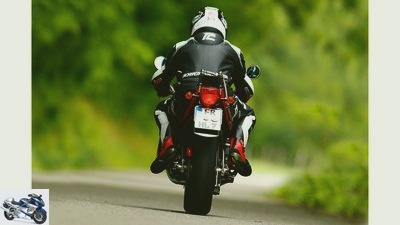
Gargolov.
10/28
Egli MRD1.
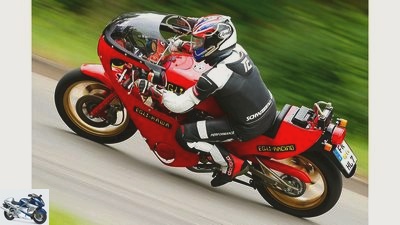
Gargolov.
11/28
Egli MRD1.
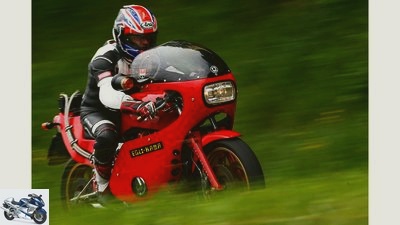
Gargolov.
12/28
Egli MRD1.
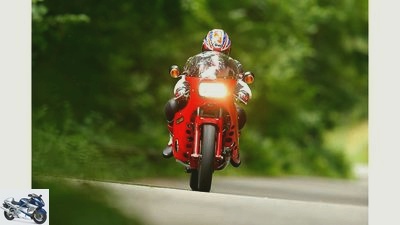
Gargolov.
13/28
Egli MRD1.
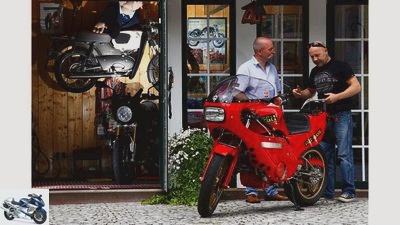
Gargolov.
14/28
Licher-Fest: The man knows how to make gourmets watery. And by no means just at the stove…
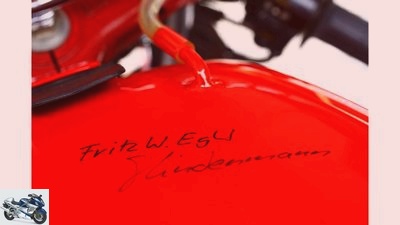
Gargolov.
15/28
"A motorcycle that you want to push the limits of is never really finished." Fritz W. Egli.
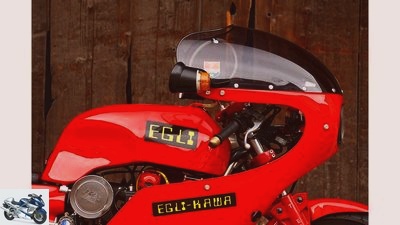
Gargolov.
16/28
Egli MRD1.
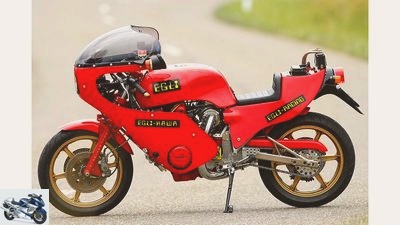
Gargolov.
17/28
Egli MRD1.

Gargolov.
18/28
Egli MRD1.
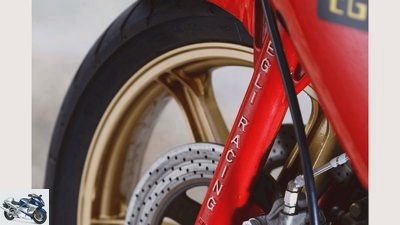
Gargolov.
19/28
Egli MRD1.
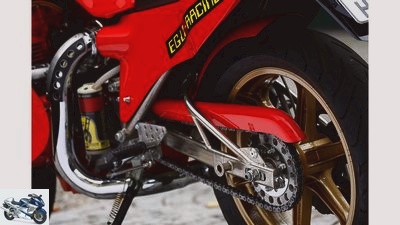
Gargolov.
20/28
Egli MRD1.
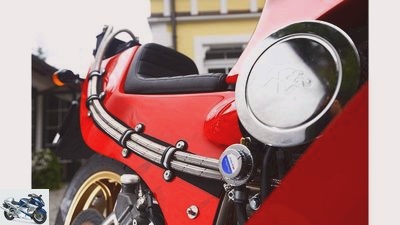
Gargolov.
21/28
The Egli MRD1 is an evolutionary step of the MRD1, which has more power thanks to the higher boost pressure and urgently needs an oil cooler for cooling. Egli installed this in the rear, the long hose lines became a characteristic feature of the MRD1.
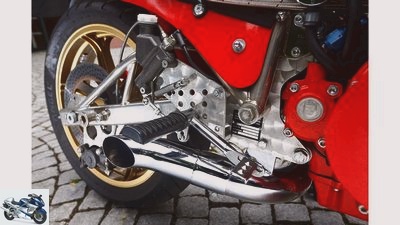
Gargolov.
22/28
Egli MRD1.

Gargolov.
23/28
Egli MRD1.
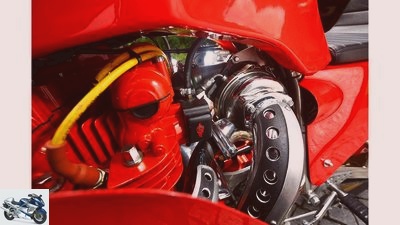
Gargolov.
24/28
The Rayjay turbocharger delivers up to 0.9 bar of boost pressure, which properly heats up the red-painted four-cylinder. Egli MRD1.
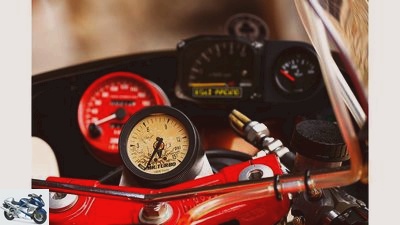
Gargolov.
25/28
Egli MRD1.
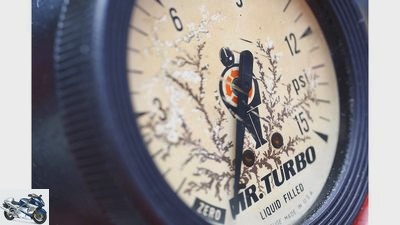
Gargolov.
26/28
Egli MRD1.
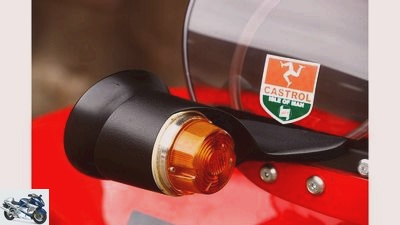
Gargolov.
27/28
Egli MRD1.
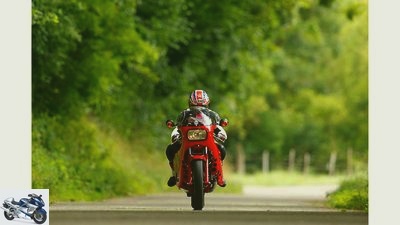
Gargolov.
28/28
Egli MRD1.
On the move with the Egli MRD1
object of desire
Content of
Try what works – this is how Fritz W. Egli took his passion for tuning Japanese high-volume technology to the extreme. With the Egli MRD1, he created a motorcycle that made seasoned men lose their sleep. And hung as a poster on the wall of many adolescents.
Of course she adorned E.also my youth room. It was a dream that gave me my first borderline experiences, because my mother seemed to instinctively suspect the seductive danger for her two-wheel-crazy offspring from this “insane bullet”. Well, I was ready to face this danger, the Egli MRD1 poster stayed on the wall after strong resistance. But from then on the Egli was a red rag for mother. And again and again a welcome occasion for controversial discussions about sense and nonsense in the life of an adolescent who had one thing in mind above all: motorcycles.
Buy complete article
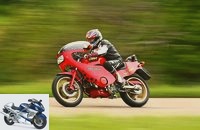
On the move with the Egli MRD1
object of desire
A feeling of respect and appreciation, but also awe
After a long time, I am sinking into the Egli cover story of MOTORRAD Revue 1979, which I picked from our archive, with these thoughts. The trigger was colleague Rolf Henniges, who was actually allowed to drive one of the very rare original Egli MRD1s owned by TV chef Horst Lichter. It was very similar to him beforehand, the memories of this red high-flyer of yore leave no one indifferent who already had more than a little gasoline in their blood.
Not even today. It doesn’t matter at all that current production motorcycles have long outperformed the Egli MRD1 in terms of performance. No, when you think of the perch, they are still there, those very special feelings from the past, which the personal hard drive has saved and reproduces as unadulterated as before when certain key stimuli are given. A strange mixture of respect and appreciation, but also awe. This can probably only be felt by those who were just as aware of the uproar around this machine at the time.
In a strange contradiction to my memories, the story about the Egli MRD1 in the MOTORRAD Revue comes across pretty sober today. I once devoured them without really understanding them. As a youngster, I simply lacked the technical understanding. However, my respect for the skills and ambition of all those involved grew with every sentence, because all technical aspects were examined in detail on almost six pages. A truly impressive list, which at least made it clear to me that a lot of effort was required to put the fastest motorcycle in the world on its wheels.
Rearview mirror PDF: Test Egli Red Falcon (MOTORRAD 08/1938)
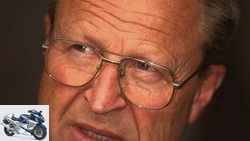
Sports & scene
What actually drives: Fritz W. Egli
20 questions to Fritz W. Egli
read more
Yoshimura five-speed racing transmission replaces the standard gearbox
Here is just an overview of the most important changes: For the Egli MRD1, Fritz W. Egli decided on the four-cylinder Kawasaki Z 900 because its housing had thicker walls than the 1000. The unit was completely dismantled, measured, drilled and then rebuilt with the lowest component tolerances. A Yoshimura five-speed racing gearbox replaced the standard gearbox, and reinforced cylinder studs and exhaust valve seats were also used. Otherwise the cylinder head remained standard. Krober contributed the ignition, the turbo kit with Rajay charger, carburetor and exhaust American Turbo Pak (ATP). The lower compression forged pistons and the special head gasket also came from the US supplier. Egli changed the oil circuit of the roller-bearing motor so that enough oil pressure could also be built up for the supercharger’s plain bearings. A pressure-controlled, electrically driven petrol pump prevented mixture loss.
For the chassis of the Egli MRD1, the mechanic opted for the cantilever variant with a central spring strut, equipped with the typical Egli fork, cast magnesium wheels and a brake system with pliers from Lockheed and cast discs from Brembo – for the first time on a motorcycle that could be registered. Overall, the construction of the MRD1 took almost five months. A surprisingly short period of time for the creation of a unique, uncompromising motorcycle that “should be created under the same criteria of reason that racing departments use to push their limits”.
1979 already 47,000 marks expensive
In mid-January 1979 the time had come: the Egli MRD1, which cost 47,000 marks, was running. 297 km / h to be exact. A sensational value, which, however, was packed into a few, somewhat hypothermic lines without any noticeable euphoria. Was it because of the cold weather? Well, my colleague Henniges was luckier, he was allowed to run this summer. And was really nervous: “It is an overcast day in July 2014 and Horst has promised me that today he will be able to drive his darling, which costs more than 50,000 euros. I am prepared, have read the old reports about the MRD1: They talk about 210 kilograms dry and 155 hp on the crankshaft. And a power to weight ratio of 1.354 kilograms per horsepower, “which comes close to that of a Formula 1 racer”.
It left me cold. After all, there is something completely different on offer today: I only say BMW S 1000 RR – 199 kilos with a full tank, measured 203 hp! We are currently at a power-to-weight ratio of less than one kilo per hp. But when Horst pushes the object of desire out of the garage, my arrogant composure suddenly gives way to a queasy feeling. This motorcycle is not just any motorcycle. Worldwide admiration was given to it, hundreds of thousands had it as a poster in the workshop or hanging over the bed. The Egli MRD1 was a dream. Back then, in the late 1970s. And it still is today. It starts with the color, that bright red that stands for love and blood, and ends with the terrifying, huge turbocharger that supposedly breathed 220 hp into this specimen here from 1982 on the test bench.
You only have to get used to the sitting position
“The tank is full,” says Horst and pats me on the shoulder. “And you are well insured. So get in, my dear! ”Get in? I feel like going to the toilet. Scared shit. The motorcycle is very expensive, the chassis failed the test. Honestly: If you push down a current sports motorcycle while standing, it springs in and out again with a smooth, dampening effect. The spring elements of this Egli MRD1, on the other hand, behave like springs with almost no damping. “You’ll see”, grins Horst, “you don’t sit too badly.” Aha.
Right. At least with regard to the seat height, which is pleasantly low at 770 millimeters. At the push of a button, the four-cylinder of the Egli MRD1, which has been bored out to 1200 cubic meters, warms up at 2000 rpm. The moment I click into first gear, two things go through my head: First, Horst explained to me that the turbocharger’s boost pressure was not set to maximum output. Second, the delivery rate of the additionally installed petrol pump may have to be adapted to the power input. Whatever that means, I’ll find out.
Ten tentatively driven kilometers later: So far I have not turned the engine above 6000 rpm. The turbocharger allegedly kicks in between 6500 and 7000 tours and ensures – as it was in all reports – over 50 meters long black lines on the asphalt. In general, the 1200 is quite comfortable to drive. It doesn’t vibrate unpleasantly, the transmission shifts precisely and easily, and the clutch, which is supposedly equipped with stronger springs, is wonderfully easy to operate. You only have to get used to the sitting position: the footrests high, the seat low, the legs strongly bent, the torso badly bent. The Egli MRD1 is not recommended for people with hip problems in the long term. The engine should gradually be warm after all, I think as this wonderful long straight in front of the front wheel rolls out …
The Egli MRD1 is still a drug
Take a deep breath and draw in the gas. While the tachometer needle fights its way forward, lines from the MOTORRAD Revue are buzzing through my head: From 4000 rpm the compressor wheel of the Egli MRD1 builds up boost pressure. The paddle wheels in the turbo rotate at a maximum of 120,000 revolutions per minute. On the inlet side, air is pressed into the cylinders via an intake bridge. The boost pressure can be varied via a manually adjustable valve. Values between 0.1 and 0.9 bar are quite normal. And if there is more, the engine threatens to burst, the excess pressure escapes through a valve to the outside. But what exactly does that mean? 0.1 bar – the Puffi set-up with around 150 hp and 0.9 bar the professional mode with 220 hp?
Window paste! Stop now and take a quick look is not possible, the engine is turning so fast. I’m totally tense, but nothing happens. Not a black line. No rising front wheel. The arms are also not drawn out or the head pressed backwards. On the contrary, at 7500 rpm the box starts to stutter. I’m disappointed. But also happy. My heart rate drops suddenly from 200 to 140. Although the Egli MRD1 steers itself incredibly easily and accurately thanks to the tires in the cutting disc format, I somehow don’t want to know whether and how the 36 mm fork and the soft suspension set-up work at almost 300 km / h tolerate. Allegedly.
A lot of air also needs a lot of gasoline
Get off, go around MRD1. Aha, there was something else: the adjustable fuel pump is set to delivery rate one. Let’s just set it to four. A lot of air also needs a lot of gasoline, otherwise the mixture is not right. Reloading. And really: the Egli MRD1 takes off from 6500 rpm. Brute, but also not much stronger than a current S 1000 RR. Nevertheless: The feeling of acceleration is completely different. Gentle but decisive. I am surprised that the MRD1 is so stable. Despite moped tires. Despite the soft suspension setup. After another 50 kilometers, I even got used to the blunt front brake. And of being gawked at all the time.
This motorcycle, the dream from the good old days, arouses desire without disappointing. Behind the huge disguise, life as a film flies past you. As if nothing is more important than what you are doing: driving. Problems disappear in the rearview mirror, the Egli MRD1 is still a drug. ”You see, mother, it’s not as bad as Rolf thinks. The only thing crazy about this “bullet” is how well it still masters the art of seduction. Tell me, where did my poster go??
Technical data Egli MRD1 (1979)
Gargolov.
The Egli MRD1, the dream from the good old days, arouses desire without disappointing.
Egli-Kawasaki MRD1
Engine: Air-cooled inline four-cylinder four-stroke engine with ATP turbocharger, two overhead camshafts, two valves per combustion chamber operated via bucket tappets, bore x stroke 70 x 66 mm, displacement 1016 cm³, compression 8: 1, output 180 hp (132 kW) at 10,000 rpm.
Power transmission: Multi-disc oil bath clutch, Yoshimura five-speed gearbox, chain drive
Landing gear: Egli central tube frame, Egli telescopic fork at the front, cantilever swing arm with Bilstein central spring strut at the rear, cast magnesium rims, front tires 100/90 V 18, rear 120/90 V 18, Brembo double disc brake at the front, Ø 280 mm, disc brake at the rear, Ø 280 m.
Mass and weight: Wheelbase 1480 mm, weight with a full tank 221 kg, tank capacity 15 l
0-100 km / h: 2.4 s (stopped by hand)
Top speed: 297 km / h
Related articles
-
On the move with the Honda NR 750
Arturo Rivas 15 pictures Alan Cathcart 1/15 The 32-valve is a technical masterpiece that only Honda has mastered Arturo Rivas 2/15 The NR sounds …
-
On the move with the Egli-Ducati 960 and Egli-Vincent 1000
Jahn 25 pictures markus-jahn.com 1/25 Egli-Ducati 960. markus-jahn.com 2/25 Double fleet: The layout of the cylinders and their heads follows the V2 …
-
fact 29 pictures fact 1/29 fact 2/29 fact 3/29 fact 4/29 fact 5/29 fact 6/29 fact 7/29 fact 8/29 fact 9/29 fact 10/29 fact 11/29 fact 12 / 29 fact 13/29 fact …
-
On the move with the Honda CBX 550 F2
Fred Siemer, Archive, Honda 18 pictures Fred Siemer, Archive, Honda 1/18 On the move with the Honda CBX 550 F2. Fred Siemer, Archive, Honda 2/18 The Honda …
-
On the move: Vincent Black Prince and White Shadow
Paulovits 19 pictures Paulovits 1/19 There are motorcycles that follow you all your life. This definitely includes Vincent’s motorcycles ….
-
On the move: the Honda VF 500 F II and Yamaha RD 500 LC
fact On the move: Honda VF 500 F II and Yamaha RD 500 LC Extreme athletes Contents from the beginning of 1984, the Honda VF 500 F II and Yamaha RD 500 LC …
-
Siemer On the move: Moto Guzzi V7 steam announcement Contents of No teeth in the mouth, but La Paloma whistle: This is how it looked when Moto Guzzi despite the highest …
-
On the move with Kawasaki GPZ 900 R and Yamaha FJ 1100
fact 39 pictures fact 1/39 Hurry with a while, always slowly with the young horses – sayings like these were definitely not up for debate when the …
-
On the move with the BMW R 69 S.
Gargolov 30th photos Gargolov 1/30 Gargolov 2/30 Gargolov 3/30 Gargolov 4/30 Gargolov 5/30 Gargolov 6/30 Gargolov 7/30 Gargolov 8/30 Gargolov 9/30…
-
On the move: BMW R 100 S, Honda CB 900 F Bol d’Or, Moto Guzzi Le Mans I.
fact On the move: big bikes from the 70s BMW R 100 S, Honda CB 900 F Bol d’Or, Moto Guzzi Le Mans I. Content of At the turn of the decade, MOTORRAD…